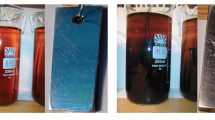Abstract
Corrosion-Electrochemical behavior of a commercial API5CT grade L80 type 13Cr tubing enriched with microalloying elements is studied in 6, 7.5, 9, 12 and 15% HCl solutions by electrochemical methods. The objective is to contribute to the comprehension of corrosion phenomena caused by HCl of similar concentrations, generally used in acidizing job. The corrosion morphology is examined by scanning electron microscopy (SEM) coupled with EDAX. The soluble corrosion products are analyzed by atomic absorption spectroscopy and colorimetric methods. General, as well as localized, corrosion is present. The severest general corrosion with a maximum rate of 26 mm/year is obtained at 15% HCl. The localized corrosion which morphologically differs as function of HCl concentrations is revealed by SEM investigation. In all the above HCl solutions, the commercial 13% Cr martensitic stainless steel tubing shows no passive state. Above 6% HCl, the microalloying elements promote forming a discontinuous film of the corrosion products. The corrosion rate slightly decreases in 15% HCl compared to the published data on a conventional 13% Cr martensitic stainless steel tubing. This is due to both the chemical composition (silicon, manganese and vanadium) and microstructural properties. Copper seems to additionally accelerate the corrosion of the alloy.
Similar content being viewed by others

References
Specification for Casing and Tubing, API Specification 5CT, Seventh Edition, October 1, 2001-ISO 11960: 2001, Petroleum and Natural Gas Industries-Steel Pipes for Use As Casing and Tubing for Wells, Effective Date: April, 2002, Proposed National Adoption.
Crolet, J.L. and Bonis, M.R., “Experience in the Use of 13% Cr Tubing in Corrosive Field,” Society Peutroleum Engineers, SPE 13552, 1975, pp. 37–44.
NACE International Work Group T-1F-21d and Task Group T-1F-21: Survey of CRA Tubular Usage, March, 1996, pp. 1–40.
Saenz de Santa Maria, M. and Turbull, A., Corrosion Science, 1989, vol. 29, no. 1, pp. 69–87.
Yoshino, Y. and Ikegaya, A. Corrosion, 1985, vol. 41, no. 2, pp. 105–113.
Gonzalez-Rodriguez et al., Corrosion, 1999, vol. 55, no. 10, pp. 991–1001.
A. Ikeda, M. Ueda, and S. Muck, Corrosion, 1983, vol. 83, no. 45.
M. Kimura, Y. Miyata, T. Toyooka, and Y. Kitahaba, Corrosion, 2001, vol. 57, no. 5, pp. 433–439.
T. Hara and H. Asahi, Corrosion, 2000, vol. 56, no. 5, pp. 533–542.
M. Kimura, Y. Miyata, Y. Yamane, T. Toyooka, Y. Nakano, and F. Murasse, Corrosion Science, 1999, vol. 8, no. 55, pp. 756–761.
S. Huizinga and W. E. Miek, Corrosion, 1994, vol. 50, no. 7, pp. 555–566.
Miyasaka, A. and Ogawa, H., “Corrosion Behaviour of Corrosion Resistant Alloys in Acid Stimulation Environments,” Corrosion 90/68 (NACE, Houston, TX, 1990).
ASTM Standard G5-87, Annual Book of ASTM Standards-Wear and Erosion (ASTM, Philadelphia, PA, 1988), Vol. 03.02.
ASTM Standard G61-87, Annual Book of ASTM Standards-Wear and Erosion (ASTM, Philadelphia, PA, 1988), Vol. 03.02.
Sedriks, A.J., Corrosion of Stainless Steels (J. Wiley and Sons, NY, 1996).
Tait, W. S., “An Introduction to Electrochemical Corrosion Testing for Practicing Engineers and Scientists,” 1994 (Pairodocs publications).
Frankel, G. S., J. Electrochemical. Society, 1998, vol. 145, no. 6, pp. 2186–2197.
Goetz, R. et al., Corrosion Science, 1985, vol. 25, no. 12, pp. 1115–1126.
Kato M. and Sakaki, T., J. Japan Inst. Metals, 1991, vol. 55, no. 10, pp. 1108–1114.
Kemp, M. et al., “Evaluation of the Corrosion and Mechanical Properties of a Range of Experimental Cr-Mn Stainless Steels,” Materials Science Engineering, 1995, vol. A199, pp. 183–194.
Miyahara, K. et al., Effects of Alloying Elements of Mn, C, and N Ageing Treatment on Corrosion Resistance of Fe-Cr-Mn Stainless Steel, Proceedings of Int. Conf. on Stainless Steels, Chiba, Iron and Steel Institute of Japan.
Wright R.N. and Wood, J.R., “Fe-Cr-Mn Microduplex Ferrite Martensitic Stainless Steel,” Metallurgical Transactions A (Physical Metallurgy and Materials Science) 1977, vol. 8A, no. 12, pp. 2007–2011.
B.J. Saldanha, “Silicon as an Alloying Element for Corrosion Resistance of Iron and Iron-Chromium Alloys,” PhD Thesis (University of Delaware, 1987).
Author information
Authors and Affiliations
Additional information
Published in Russian in Zashchita Metallov, 2007, Vol. 43, No. 4, pp. 372–380.
The article was translated by the authors in English.
Rights and permissions
About this article
Cite this article
Chermat-Aourasse, N., Kesri, R. Corrosion-Electrochemical behavior of 13% chromium (Cr) martensitic stainless steel in hydrochloric acid (HCl) solutions. Prot Met 43, 344–352 (2007). https://doi.org/10.1134/S0033173207040054
Received:
Issue Date:
DOI: https://doi.org/10.1134/S0033173207040054


